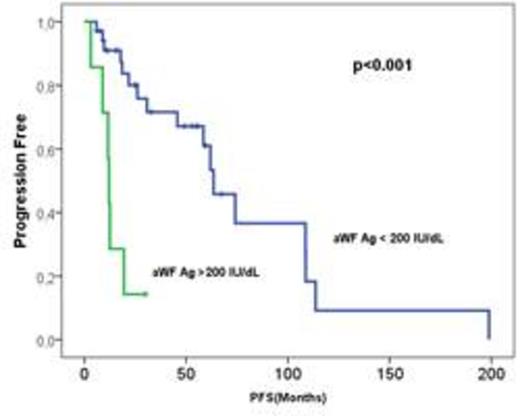Abstract
Waldenstrom's Macroglobulinemia (WM) is an uncommon malignancy which is characterized by the infiltration of the bone marrow by lymphoplasmacytic cells, which produce a monoclonal IgM. The manifestations of the disease are related to the infiltration of the bone marrow and the quantity, physical and immunological properties of the monoclonal IgM. The interactions of lymphoplasmatic cells with other cells in their microenvironment, including mast cells and endothelial cells, support their survival and proliferation and may induce resistance to therapy. Von Willebrand factor (vWF), a glycoprotein produced by the endothelial cells and megakaryocytes, plays a key role in primary hemostasis but is also a marker of endothelial “stimulation”. Recently, it was shown that high levels of vWF, measured in citrated plasma, are associated with adverse prognosis in patients with symptomatic WM and it was suggested that vWF levels may reflect interactions between lymphoplasmacytic cells and other cells of their microenvironment such as mast cells and endothelial cells (Hivert et al; Blood 2012;120:3214-21). Thus, we evaluated the prognostic importance of vWF antigen levels in the serum of patients with symptomatic previously untreated WM, in order to validate vWF as a possible prognostic marker for progression free (PFS) and overall (OS) survival and to validate the measurement of vWF in the serum instead of citrated plasma.
The vWF antigen (vWF Ag) levels were measured in serum collected before initiation of therapy by means of a latex particle-enhanced immunoturbidimetric assay (HemosIL vWF antigen) with an automated coagulometer (ACL Top 3G, Instrumentation Laboratory, Lexington, MA, USA). The inter-assay and intra-assay coefficients of variation were 2% and 3% at a concentration of 123.5 U/dL, respectively, and the lower limit of detection was 2.2 U/dL.
The analysis included 42 patients with symptomatic WM, treated at the Department of Clinical Therapeutics, University of Athens (Greece), from 1999 to 2012, and 19 healthy controls of matched gender and age. The median age of patients with symptomatic WM was 65 years (range: 37-83 years) and 54% of them were males. Anemia (<11.5 g/dL) was present in 78% of patients, lower platelet counts (<100x109/L) in 17%, beta2-microglobulin >3 mg/dl in 56%, while 7.5% had serum LDH ≥250 U/L and 58% had serum albumin <3.5 g/dL. Median serum IgM was 3340 mg/L (range 246-9563 mg/dL). According to IPSSWM, 22% had low, 43% intermediate and 35% high risk WM, respectively. Reasons to initiate therapy included cytopenias in 42% of patients, B-symptoms in 15%, hyperviscosity in 12%, neuropathy in 10% and other reasons in 21%. Primary therapy based on rituximab was given in 93% of the patients and 54% achieved at least 50% reduction of IgM.
Median serum level of vWF Ag was 101 U/dL (mean 132.5 U/dL, range 19.9-399 U/dL) and were slightly higher compared to the serum levels of healthy controls (median 85 U/L, mean 85 U/L, range 48-124 U/L). However, 6/42 (14%) had vWF Ag levels <40 U/L; which could be compatible with acquired vWF syndrome but no further investigation was performed.
There was an inverse correlation of platelet counts with levels of vWF Ag (R=-0.336, p=0.032) and vWF Ag ≥median was more frequent in patients with beta2-microglobulin >3 mg/L (p=0.006) and less frequent in patients with low (11%) vs. patients with intermediate (59%) or high (62%) risk IPSS (p=0.036). There was no correlation of vWF Ag levels with IgM levels or with the extent of bone marrow infiltration or with other manifestations of the disease.
Median follow up of symptomatic patients was 4 years. Patients with vWF Ag levels within the upper quartile (i.e. vWF Ag ≥200 U/dL) had a median progression free survival of 12 months vs. 63 months of patients with vWF Ag < 200 U/L (p<0.001), while the median survival for patients with vWF Ag ≥200 U/dL was 37 months (4-year survival 29%) vs. 4-year survival of 97% for patients with vWF Ag <200 U/L (p<0.001; Figure).
No relevant conflicts of interest to declare.
Author notes
Asterisk with author names denotes non-ASH members.



